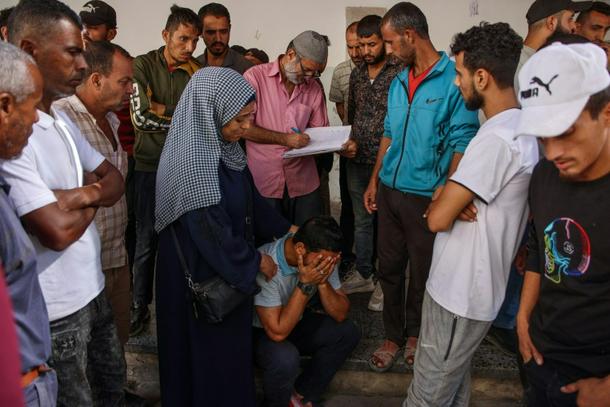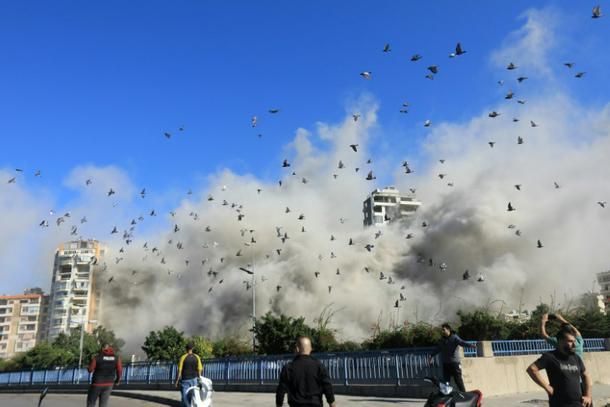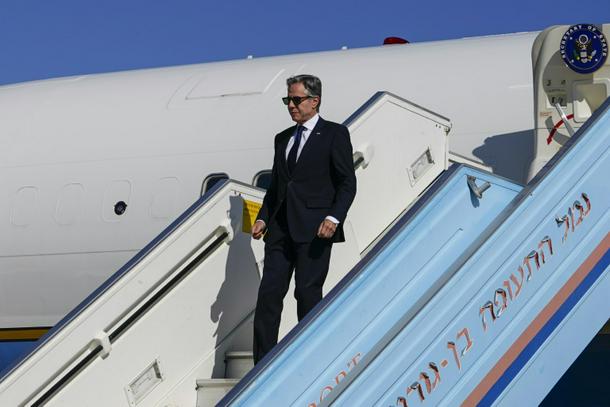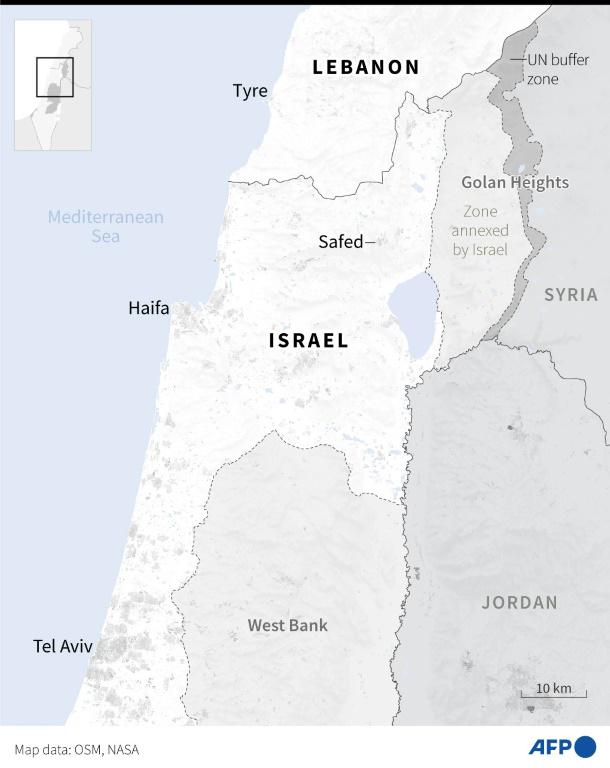
Efforts for a Gaza ceasefire have so far failed
Jerusalem (AFP) - US Secretary of State Antony Blinken met Israel’s prime minister Tuesday to push for a ceasefire in Gaza after his administration called for an end to the war in Lebanon “as soon as possible”.
It is his 11th trip to the Middle East since Hamas’s attack on Israel more than a year ago triggered the Gaza war, and his first since Israel’s conflict with Hezbollah escalated late last month.
His meetings with Israeli Prime Minister Benjamin Netanyahu and other top officials come as Israel weighs its response to Iran’s October 1 missile attack.
In Lebanon, Israel hit an area of south Beirut housing the country’s largest public health facility, killing 13 people, according to the health ministry.
The Rafic Hariri Hospital, located outside Hezbollah’s traditional strongholds, sustained minor damage in the strike which flattened four nearby buildings, an AFP correspondent reported.

Smoke and pigeons rise after an Israeli strike on Beirut's southern suburbs
Previous US efforts to end the Gaza war and contain the regional fallout have failed, as did a bid spearheaded by President Joe Biden and his French counterpart Emmanuel Macron to secure a temporary ceasefire in Lebanon.
After Israel, Blinken will visit Jordan on Wednesday and discuss humanitarian aid for the Gaza Strip, an official on the plane with him said.
Blinken also plans to speak to Israeli leaders about the expected strike on Iran and discourage any move that could massively escalate regional conflict, the official said.
- Night of strikes -
On Monday, US envoy to Lebanon Amos Hochstein said his administration was seeking an end to the war “as soon as possible” as he pushed for a ceasefire based on a UN resolution that ended an earlier Israel-Hezbollah war.

US Secretary of State Antony Blinken arrives in Israel in his latest push for a ceasefire in Gaza
Under Resolution 1701, Hezbollah should have withdrawn from areas in south Lebanon near the Israeli border, leaving only the country’s weak military and UN peacekeepers deployed there.
But Hezbollah remained south of Lebanon’s Litani River, and in October last year began launching low-intensity cross-border strikes into Israel, in support of its Palestinian ally Hamas.
After nearly a year of war in Gaza, Israel shifted its focus to Lebanon, vowing to secure its northern border to allow tens of thousands of Israelis displaced by the cross-border fire to return to their homes.
Israel ramped up its air strikes on Hezbollah strongholds around the country sent in ground troops late last month, in a war that has killed at least 1,489 people since September 23, according to an AFP tally of Lebanese health ministry figures.

Smoke rises from the site of an Israeli air strike that targeted the southern Lebanese village of Khiam
The strike on Monday night came as Israel targeted Beirut’s southern suburbs with heavy fire after issuing evacuation warnings for multiple districts.
One Israeli strike on Tuesday came just minutes after a Hezbollah official cut short a news conference in response to an Israeli warning, an AFP correspondent said.
The strike hit a few hundreds of metres (yards) away just minutes after journalists left, the correspondent said.
Hezbollah spokesman Mohammed Afif confirmed that the group carried out a drone attack targeting the Israeli prime minister’s home last week, and acknowledged that some of its fighters had been captured by the Israeli army.
On Saturday, Netanyahu accused Hezbollah of attempting to assassinate him and his wife after a drone was launched towards his residence in the central town of Caesarea.
A Lebanese security official told AFP that the country’s national airline had to switch landing strips after Israeli strikes near Beirut’s only international airport hit close to the main runway.
In the heavily bombarded south, the Lebanese Red Cross said an Israeli strike wounded three of its paramedics in the city of Nabatiyeh who were responding to reports of casualties from an earlier strike.

An Israeli air strike hits Beirut's southern suburb of Shayah
State media reported Israeli air strikes near the coastal city of Tyre.
Hezbollah said it launched rockets at two positions in the suburbs of Israel’s commercial hub Tel Aviv and a naval base near the northern city of Haifa.
The wars in Gaza and Lebanon have also drawn in other Iran-aligned armed groups, including in Yemen, Syria and Iraq.
Iran said on Tuesday it had received assurances from its neighbours that they would not allow the use of their airspace for any attack against it, after Israel pledged to hit back against its October 1 missile attack.
- ‘We will die of hunger’ -
In the Gaza Strip, Israel launched a major air and ground assault in northern Gaza earlier this month, vowing to stop Hamas militants from regrouping in the area.

North of Israel and south of Lebanon
Gaza’s civil defence agency said four Palestinians were killed in strikes on Monday, while several homes were blown up in the northern area of Jabalia, a focal point of the recent fighting.
A displaced resident said Jabalia “is being wiped out”.
“If we don’t die from the bombing and gunfire, we will die of hunger,” said 42-year-old Umm Firas Shamiyah, demanding aid be sent to the north.
Despite the exodus of tens of thousands of civilians, around 400,000 have been trapped by the fighting, the UN agency for Palestinian refugees warned last week.
Washington has warned it may suspend some of its military assistance if Israel does not quickly improve humanitarian access to the area and Blinken was expected to raise the issue in his talks with Netanyahu.
The war was sparked by Hamas’s unprecedented attack on Israel on October 7 last year, which resulted in the deaths of 1,206 people, mostly civilians, according to an AFP tally of Israeli official figures.
Israel’s retaliatory offensive has killed 42,718 people in Gaza, also mostly civilians, according to figures from the Hamas-run territory’s health ministry which the UN considers reliable.
burs-kir/dl